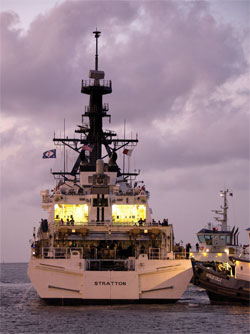 |
|
Courtesy Huntington Ingalls Industries |
|
USCGC Stratton, the third National Security Cutter, pulls away from the dock at Ingalls Shipuilding for acceptance trials. |
Within a month of taking office this summer as Secretary of Defense, Leon Panetta was pleading with Congress not to slash the Pentagon budget, already on the hook for $350 billion in cuts over the next 10 years.
That might still happen. But there's a little breathing room.
"The FY12 budget is pretty robust," said Joe Carnevale, the retired rear admiral who follows the defense industry for the Shipbuilders Council of America. "The Navy … kind of put their money where their mouth is: They actually put more ships into the FY12 budget and the nearer years. That said, what happens in '13? … There's a whole lot of numbers being thrown around. Where it lands, who knows?"
What shipyards hate is seeing ship construction "pushed to the right" — held over, sometimes endlessly, from one fiscal year to the next. Bill Skinner, CEO of VT Halter Marine in Pascagoula, Miss., has watched that happen with the U.S. Coast Guard's Offshore Patrol Cutter (OPC), a contract hotly pursued by several yards.
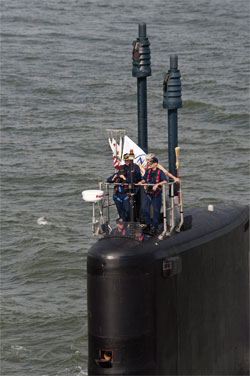 |
|
Courtesy Huntington Ingalls Industries |
|
California, the newest nuclear sub, returns to Newport News Shipbuilding. The broom on its mast symbolizes a clean sweep and successful sea trial. |
"We're very, very concerned about what's going to happen to the defense budget," said Skinner. "Fifty percent of our work is government related right now. We're building fast missile craft, oceanographic ships, the T-AGM 25 … We have the ship-to-shore connector that we're actively pursuing, the OPC, the replacement of the Navy oilers — we would hope that all those programs stay."
The Navy's showpieces — aircraft carriers, submarines, complex surface combatants and big-deck amphibious craft — can only be built by large, specialized yards. The current concern for Huntington Ingalls Industries' Newport News, Va., yard is a possible delay in authorizing construction of the next $10.3 billion carrier, John F. Kennedy. Underscoring the debate, China's first aircraft carrier has just completed its initial sea trials.
Bath Iron Works received word in September that it will in fact build a third Zumwalt-class destroyer, designed with two 155-mm guns for shore support. Bath is building the hulls; Huntington Ingalls is building the deckhouse at its composite materials plant in Gulfport, Miss. Bath's latest Arleigh Burke-class guided missile destroyer, Spruance, left the yard in September; the next flight of this class will field a much bigger radar for ballistic missile defense.
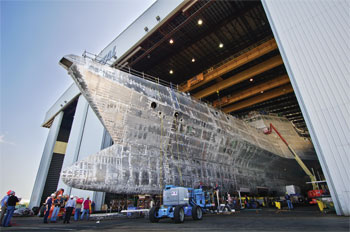 |
|
Brian Gauvin |
|
Austal USA readies its second Littoral Combat Ship for launch. |
Another vessel being built by multiple yards is the Littoral Combat Ship (LCS). Austal USA in Mobile, Ala., is turning out 418-foot trimaran versions and Marinette Marine in Wisconsin is producing 377-foot mono- hulls (Lockheed Martin leads the consortium building the latter). Neither build has been trouble free — Austal's first boat suffered galvanic corrosion and Lockheed Martin's sprang cracks between hull plates — but the Navy is sticking with plans to order 55 LCSs and there is once again talk of adapting the design for foreign navies (three years ago it was Israel, now it's Saudi Arabia and Australia).
On the West Coast, General Dynamics Nassco currently has no new commercial newbuilds underway. The final two underway replenishment vessels in a 14-vessel contract are finishing up, so it was perfect timing when the Navy awarded the shipyard a $744 million contract to build two mobile landing platform ships for delivery in 2013 and 2014 and a $60 million contract to buy long-lead materials for a third.
The ships are based on a Nassco tanker design but will carry modules to support the Navy's Maritime Prepositioning Ship squadrons. They are designed to transfer vehicles and equipment at sea and load them onto surface connectors for delivery to shore.
Like another West Coast yard, Vigor (formerly Todd) in Seattle, Nassco benefits from a steady stream of Navy repair work to supplement construction.
One recent trend has been a move by mid-tier shipyards, particularly in the Gulf, into Navy construction — Austal USA is a good example. Building for agencies such as NOAA or the U.S. Geological Survey is an extension of this, benefiting yards such as VT Halter Marine and Marinette Marine.
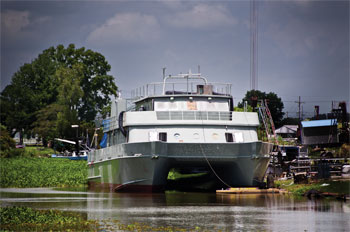 |
|
Brian Gauvin |
|
Thoma-Sea Marine in Lockport, La., is building a 90-foot hydrographic survey ship for the government of Oman under a Foreign Military Sales contract. |
Another source of contracts is Foreign Military Sales. One yard, Thoma-Sea Marine, of Lockport, La., took its first venture into this world when it contracted to build a $7.3 million hydrographic survey vessel for the government of Oman.
The boat is based on a University of Miami research vessel. "It's a good job to cut our teeth on because it's a commercial build, it's not a military spec build," said Walter Thomassie, the yard's general manager. "Conventional and military are totally different. We're just going to see where it leads — we're planning on competing for other projects."
The biggest prize out there in Foreign Military Sales is a 30-boat order of fast patrol vessels for Saudi Arabia. The length would be between 115 and 150 feet, which puts them within the range of yacht builders such as Westport Yachts on the Olympic Peninsula and Trinity Yachts in the Gulf.
Bollinger Shipyards in Lockport, La., has launched the first two vessels in a new series of 154-foot Coast Guard patrol boats. The Coast Guard needs to replace its aging fleet fast, but its very expensive National Security Cutters (steel has just been cut on the fourth) are swallowing a big portion of its construction budget.
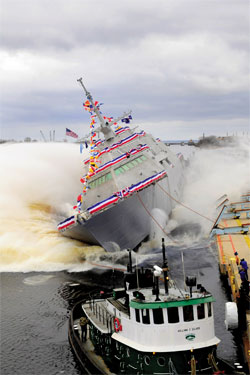 |
|
Courtesy Lockheed Martin/U.S. Navy |
|
Marinette Marine launches Fort Worth, Lockheed Martin’s second Littoral Combat Ship. |
Smaller military vessels have kept some shipyards busy for several years; Kvichak Marine Industries devoted a whole facility in Kent, Wash., to 45-foot Coast Guard response boats and recently won a five-year contract for up to 80 32-foot 9-inch transportable port security boats. However, this segment of the industry has seen some shakeup this year. Aluminum Chambered Boats in Bellingham, Wash., shut down at the end of last year, and SeaArk Marine in Monticello, Ark., is no longer taking new orders.
If Navy shipbuilding does take a hit, it's worth bearing in mind that those who are keen to wield the ax will not have to look far for an example of wasteful spending. The Navy finally cut its losses this year on Henry Eckford and Benjamin Isherwood, two Henry J. Kaiser-class oilers that were left unfinished almost 20 years ago and never joined the fleet.
Will new ships get pushed to the right? A presentation at a recent American Society of Naval Engineers symposium in San Diego was titled: "Taking a 40-Year Ship to 70 Years" — a reference to the Navy's decision to extend the life of its two command ships, built in 1970 and 1971, to 2039. Let's hope that's not an omen.
